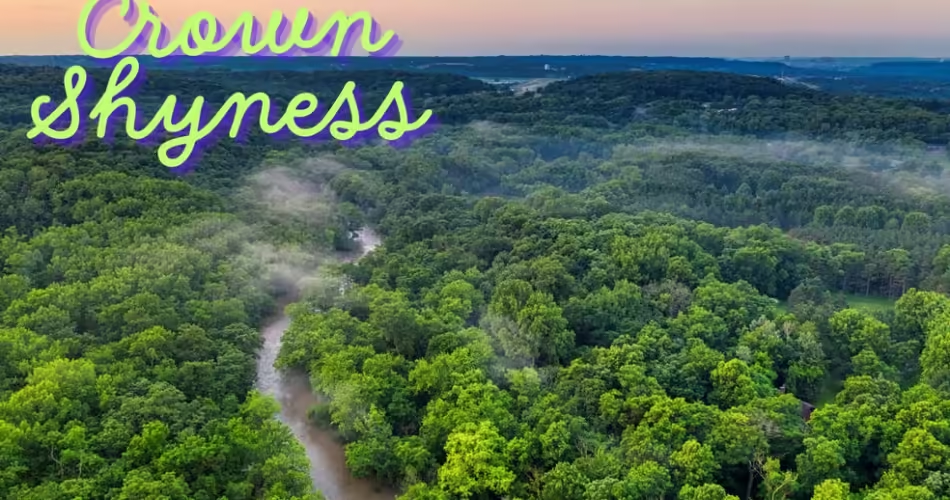This blog tells about the phenomenon of Crown shyness. First, it explains the process of crown shyness. Then it explains the theories that science introduces for crown shyness. Secondly, it elaborates the benefits of crown shyness along with the species involved in crown shyness. Then it discusses the factors that cause crown shyness in species. At the end, it will aware you about some lessons to learn from crown shyness. This blog contains Theories, Benefits, species, factors and lessons of crown shyness.
What is Crown Shyness?
It is the phenomenon in which trees do not touch the leaves of other trees. In this phenomenon trees avoid to touch other trees in every condition. We can call this condition as Canopy shyness.
Crown shyness, a captivating phenomenon observed in certain tree species, results in crack-like gaps within the forest canopy. Imagine standing beneath a lush green roof, and instead of leaves touching, there are intriguing channels of blue sky sneaking through the branches.
It seems like trees are almost touching each other but they are not actually touching leaves of other trees. This is a breathtaking moment to witness crown shyness.
We can also call it as canopy disengagement or inter-crown spacing, occurs when fully stocked trees intentionally avoid touching each other. Their crowns maintain a respectful distance, creating geometric patterns unique to each tree. These gaps allow light to filter through, illuminating the forest floor like a natural stained-glass window.
Research on Crown Shyness:
Researchers have found that crown shyness is induced by physical damage, abrasions and collisions due to wind movement. Trees seem to protect one another, preventing branches from cracking and breaking during storms. It’s as if they’ve mastered the art of social distancing long before humans did. In the Forest’s Whisper Below the canopies, a hidden network of fungal threads connects tree roots, allowing them to share nutrients and communicate. In both layers the sky-touching crowns and the earth-bound root of trees play a delicate balancing act. They can either help or hinder their neighbors, much like our own interactions. Crown shyness may exist between the trees of different species or sometimes between same species of the trees. We can notice it between the branches of the same tree.
Crown shyness phenomenon creates a beautiful web of trees when we see from down the trees or above the trees. It is really an amazing art of nature in which trees are supposed to touch the leaves but they do not touch them. We will learn about Theories about Crown shyness and lessons to learn in this article.
Science behind Crown Shyness:
As we know that it is impossible to understand phenomena of nature. We cannot tell exactly what is leading them and what is its cause. We can only predict the reality and introduce different theories about it. Crown shyness is also one of those phenomena that is unknown to us and we don’t know the reason behind it. There are two theories that are proposed to explain Crown Shyness. These are explained as follows:
Theory no 1:
The first theory suggest that interdigitation of branches leads to “Reciprocal pruning” of adjacent trees. We can see that in windy areas trees colloid with each other harshly and cause damage to their leaves. These abrasions and collisions results in crown shyness. In this theory the explanation can be that trees avoid their growth on the area with other trees can be established. This avoid the further damage of the tree leaves and they all remain healthy on their own location.
Theory no 2:
Another theory suggests that the ability of trees to sense nearby plants. This theory tells us the red light that is reflecting from plants, tells other nearby plants about their existence and location. This red light hits the leaves of nearby trees. Branches naturally avoid to touch or colloid with each other to prevent damage of the leaves and avoids preventing their proper growth. This avoid other plants to make shade on others and prevent their growth. That is why they make gaps into the canopy to avoid such damage.
In early 1920’s scientists assumed that the phenomenon is due to the lack of light resources that are unable to pass from thick clusters of leaves but in 1984 a biologist named Francis Jack Putz and his team concluded that the actual cause of this phenomenon is ‘Wind’. The stronger the wind blows the more spreader canopies of mangroves are from other trees. The hypothesis that explains this is called treetop patterns.
About two decades later another biologist Mark Rudinick found that forests with strong wind and tall trees are more prone to crown shyness. Others relate it to chemical communication.
Benefits of crown shyness:
Regardless of how the phenomenon takes place it provides a great deal for the trees to survive. Leaves are the most important part of a tree if they fall down or catch any pest it can bring down the whole tree at once. The gaps help trees to avoid invasive woody vine i.e. lianas -most common in tropical forests all over the world and it also provides a barrier against disease causing pest/ microbes and also from those insects that uses tree branches to move from one tree to another. It also helps the rain water to reach the bottom of trees without any blockage.
For example, the trees with lianas have about more than 10 species of ants and other pests whereas the trees without an entanglement have 6 or fewer species. They are not completely disconnected or attached to each other. The phenomenon serves a perfect harmony and balance within their vicinity. The trees don’t harm each other but provides the required help.
Although it is not possible for many biologists to study those long gigantic trees that spread around the world which seems so unfair to them as if studying a human body only from the bottoms.

Species that are involved in Crown Shyness:
This has been seen mostly in certain European oak and pine species, and also in tropical and subtropical species. For example, some eucalyptus, types of the Dryobalanops genus, Pinus contorta, Avicennia germinans, Didymopanax pittieri, Clusia alata, Celtis spinosa, Pterocymbium beccarii, Picea sitchensis and Larix kaempferi. Simply known as:
- Black Mangrove Trees
- Camphor Trees
- Eucalyptus
- Sitka Spruce
- Japanese Larch
- Pine trees
- Maple
In different species, the highest parts of the trees come in contact with each other and even cross their branches, although the canopy (territory that incorporates the highest parts of the trees) does not usually mix completely.
These are some of the species that exhibits the phenomenon of Crown shyness but not all trees around the earth are capable of doing so.
Factors that influence the phenomenon of crown shyness:
Certainly! The several factors influence the occurrence of Crown Shyness in species:
Light Competition:
Trees avoid overlapping crowns to maximize access to sunlight. When neighboring trees’ branches touch, they compete for light, leading to crown shyness.
Wind Movement:
Gaps between crowns reduce wind resistance. This prevents branches from rubbing against each other during windy conditions, minimizing damage.
Disease Prevention:
By avoiding physical contact, trees reduce the risk of disease transmission. Fungal spores and pathogens can spread through direct contact.
Genetics:
Some species have inherent crown shyness tendencies due to their genetic makeup. Others exhibit it based on environmental cues.
Branch Flexibility:
Flexible branches are less likely to break when they sway in the wind. Crown shyness helps maintain this flexibility.
Remember, not all trees exhibit this behavior but these factors contribute to the fascinating phenomenon of crown shyness. We have discussed Theories on Crown Shyness and Lessons to learn in this blog.
Anthropogenic effects on crown shyness:
As discussed earlier that most of the shy trees are found in tropical areas which are now most prone to anthropogenic activities i.e. urbanization which has a direct link to climate change. The patterns of the trees are also changing due to the altered patterns of winds, levels of precipitation and increased temperatures which may result in crown collisions.
Lessons to Learn:
Nature’s phenomena teaches us at every step of our lives.
• Crown shyness is teaching us to protect plants on their own. But unfortunately we are cutting forests for economical use and population consumption. We are going away from nature day by day.
• Another lesson is that we should give space to each and every individual to learn and grow properly without stopping and avoiding them to go forward, same as the plants are staying away from each other to let each other grow properly. If we will give space to others, our life will also be free, otherwise we will be trapped in our own self.
• These crown shyness teaches us to be in our own circle or boundary without interfering in other’s lives and let others have their own experience and decisions.
In this way nature explains us untold and unknown silent lessons that we are unable to understand and apply. We should observe the lessons that the nature explains, but first we should conserve it by avoiding deforestation, over exploitation of resources, avoiding pollution and avoid wastage of water. By apply all these strategies, we can be able to understand the nature and the lessons explained by the nature.
We discussed the phenomenon of Crown Shyness, its theories and lessons to learn in this blog.

To learn about more topics, click the link below:


Comments